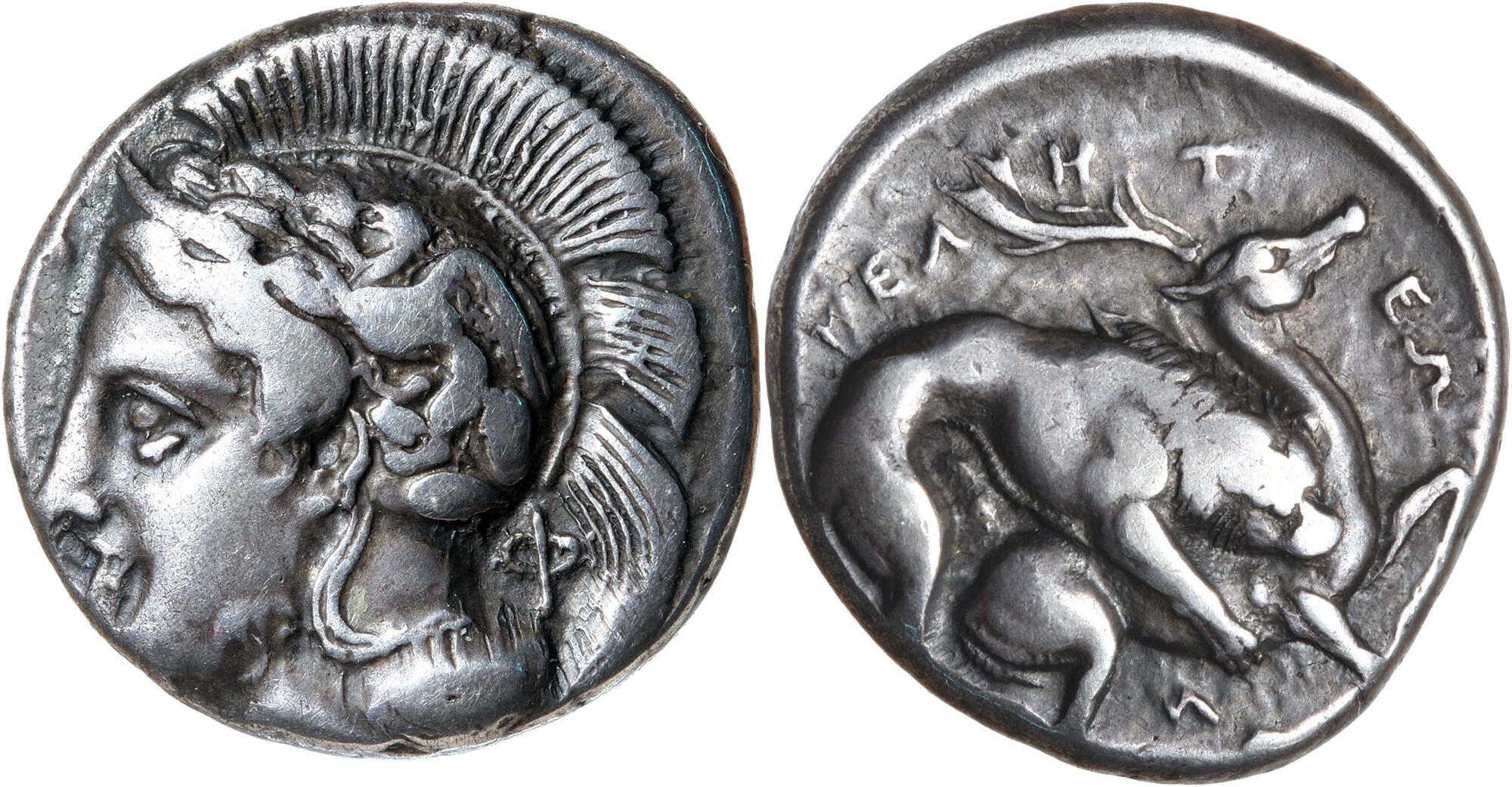Velia, silver, didrachms (440-400 BCE)
From SILVER
440 BCE - 400 BCE Silver 2,890 kg
Description
| ObverseInscription or printing placed on the obverse.: | Head of Athena left, wearing crested Attic helmet decorated with griffin and wreath |
| ReverseInscription or printing placed on the reverse.: | YEΛHTEΩN (Greek).Lion attacking stag right, legend above around |
Mint and issuing power
| MintIdentifies the place of manufacture or issue of a numismatic object.: | Velia | Ancient regionAncient region.: | Lucania | Modern countryModern country: Italy | AuthorityIdentifies the issuing power. The authority can be "pretended" when the name or the portrait of X is on the coin but he/she was not the issuing power. It can also be "uncertain" when there is no mention of X on the coin but he/she was the issuing power according to the historical sources: |
Chronology
| FromIdentifies the initial date in a range assigned in a numismatic context. | 440 BCE | toIdentifies the final date in a range assigned in a numismatic context.. | 400 BCE | PeriodTime period of the numismatic object.: Classical 480-323 BC |
Physical description
| MetalThe physical material (usually metal) from which an object is made.: | Silver |
Median weightMedian of the weights of numismatic objects (in grams). in grams | 7.65 | DenominationTerm indicating the value of a numismatic object. Examples: tetradrachm, chalkous, denarius.: | didrachm |
StandardStandard.: |
Image

AC 13 - Velia, silver, didrachm, 440-400 BC.jpg [1]
References
| Die study referencePublication of the study: | Williams 19921Williams 1992, Group III: varieties 132-169 (O91-109 and R102-126) | ||
| Coin series referenceReference to coin series study: | RQEMAC2RQEMAC, n° 13, HN Italy3HN Italy, n° 1270, HGC 14HGC 1, n° 1304 | ||
Obverse dies distribution
| FrequencyFrequency of specimen in distribution. ᵖ | Number of obversesNumber of obverse dies. ᵖ (o) | % (o) | Number of coinsNumber of coins. (n) | % (n) | Die nameName(s) of the die(s). |
| 3 | 2 | 10.53 | 6 | 2.37 | 91, 101 |
| 4 | 1 | 5.26 | 4 | 1.58 | 97 |
| 5 | 1 | 5.26 | 5 | 1.98 | 100 |
| 6 | 2 | 10.53 | 12 | 4.74 | 92, 93 |
| 7 | 1 | 5.26 | 7 | 2.77 | 104 |
| 8 | 1 | 5.26 | 8 | 3.16 | 99 |
| 9 | 1 | 5.26 | 9 | 3.56 | 94 |
| 11 | 2 | 10.53 | 22 | 8.7 | 98, 109 |
| 15 | 1 | 5.26 | 15 | 5.93 | 105 |
| 17 | 1 | 5.26 | 17 | 6.72 | 108 |
| 18 | 1 | 5.26 | 18 | 7.11 | 103 |
| 21 | 1 | 5.26 | 21 | 8.3 | 102 |
| 23 | 1 | 5.26 | 23 | 9.09 | 96 |
| 25 | 1 | 5.26 | 25 | 9.88 | 95 |
| 29 | 1 | 5.26 | 29 | 11.46 | 105 |
| 32 | 1 | 5.26 | 32 | 12.65 | 107 |
| Total | 19 of 19 | 99.97 | 253 of 253 | 100 |
Reverse dies distribution
no distribution is available
Quantification
| Number of obversesNumber of obverse dies. ᵖ (o) | 19 | Number of singletons (o1)The number of singleton coins. ᵖ | |
| Number of reverse diesNumber of reverse dies. (r) | 25 | Number of coinsNumber of coins. (n) | 253 |
| Coins per obverse dieNumber of coins per obverse die. (n/o) | 13.32 | Coins per reverse dieNumber of coins per reverse die. (n/r) | 10.12 |
| Reverse per obverse ratioRatio of obverse dies divided by reverse dies. (r/o) | 1.32 | Percentage of singletons (o1)number of coins (n) divided by the number of singletons (o1) ᵖ | % |
| Original number of dies (O) (Carter 1983 formula)The estimation of the number of coins according to Carter 1983 ᵖ | 18.89 | Coins struck if 20,000 as average productivity per dieCoins made if the average productivity for obverses (according to Carter) is 20,000. ᵖ | 377,800 |
| Original number of dies (O) (Esty 2011 formula)The estimation of the number of coins according to the singleton formula in Esty 2011 ᵖ (O) | 20.54 | Survival rate if 20,000 as average productivity per dieSurvival rate if average productivity is 20,000. ᵖ | 0.00067 |
| Coverage (o = % of O) (Esty 1984 formula)Esty 1984 - coverage (% of O) ᵖ (o = % of O) | % | Die productivity if survival rate 1/2,000Average productivity if survival rate is 1/2,000. ᵖ | 26,786.66 |
| Weight of silver (in kg) if 20,000 coins per die (O = Carter formula)Carter 1983 * Median weight * 20000 (*10 if gold or electrum) ᵖ | 2,890 kg <br /> 2,890 kg | Die productivity if survival rate 1/5,000Average productivity if survival rate is 1/5,000. ᵖ | 66,966.65 |
Remarks